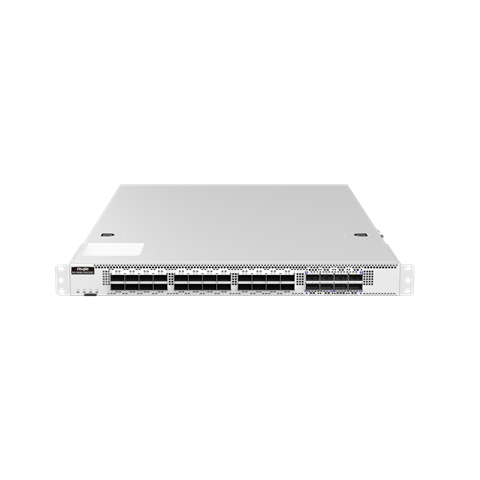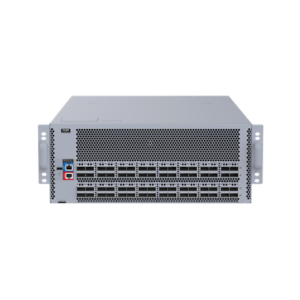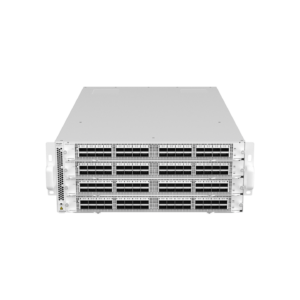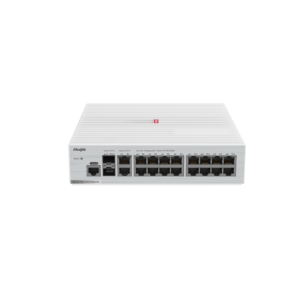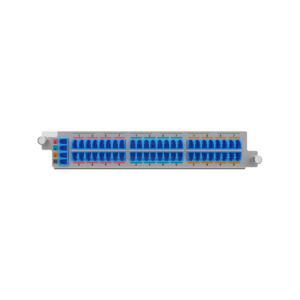Hardware Specifications
| System Specifications | RG-S6580-24DC8QC |
| Ports | 24 × 200GE ports (QSFP56) + 8 × 400GE ports (QSFP-DD) |
| Expansion Modules | Not supported |
| Expansion Module Slots | Two power supply module slots (1+1 redundancy)
Six fan module slots (5+1 redundancy; the system needs at least 5 fan modules) |
| Management Port | One management port, one console port, and one USB port, compliant with the USB2.0 standard |
| Switching Capacity | 16.0 Tbps |
| Packet Forwarding Rate | 5350 Mpps |
| 802.1Q VLAN | 4094 |
| Dimensions | RG-S6580-24DC8QC |
| Dimensions (W × D × H) | 442 mm × 670.8 mm × 43.6 mm, 1 RU |
| Power Supply and Consumption | RG-S6580-24DC8QC |
| Power Input | AC input:
Rated voltage range: 200 VAC to 240 VAC Maximum voltage range: 90 VAC to 264 VAC Frequency: 50 Hz to 60 Hz Rated input current: 8 A HVDC input: Input voltage range: 192 VDC to 288 VDC Rated input current: 6.5 A |
| Overall Power Consumption | Static power consumption: 180 W
Dynamic power consumption (maximum): 794 W Typical power consumption: 450 W |
| Environment and Reliability | RG-S6580-24DC8QC |
| Temperature Alarm | Temperature alarms and overheat protection |
| EMC | GB/T 9254.1 |
| Safety Regulation | GB 4943.1 |
| Operating Temperature | 0ºC to 40ºC |
| Storage Temperature | –40°C to 70°C |
| Operating Humidity | 10% to 90% RH (non-condensing) |
Software Specifications
| Software Specifications | RG-S6580-24DC8QC |
| L2 Protocols | IEEE 802.3x, IEEE 802.3ad (Link Aggregation Control Protocol), IEEE 802.1p, IEEE 802.1Q, IEEE 802.1D (STP), IEEE 802.1w (RSTP), IEEE 802.1s (MSTP), Jumbo Frame (9 KB) |
| L3 Protocols (IPv4) | BGP4, OSPFv2, RIPv1, RIPv2, LPM routing, Policy-based Routing (PBR), route-policy, Equal-Cost Multi-Path Routing (ECMP), WCMP, VRRP |
| IPv6 Basic Protocols | Neighbor Discovery, ICMPv6, Path MTU Discovery, DNSv6, DHCPv6, ICMPv6, ICMPv6 redirection, ACLv6, TCP/UDP for IPv6, SNMP v6, Ping/Traceroute v6, IPv6 RADIUS, Telnet/SSH v6, FTP/TFTP v6, NTP v6, IPv6 MIB support for SNMP, VRRP for IPv6, IPv6 QoS |
| IPv6 Features | Static routing, ECMP, PBR, OSPFv3, RIPng, BGP4+ |
| Data Center Features | PFC, ECN, and other data center features
RDMA |
| Visualization | gRPC
sFlow sampling |
| QoS | Mapping of IEEE 802.1p, DSCP, and ToS priorities ACL-based traffic classification Priority marking/remarking Multiple queue scheduling mechanisms, including SP, WRR, WFQ, DRR, SP+WRR, SP+WFQ, and SP+DRR Congestion avoidance mechanisms such as WRED and tail discarding |
| HA Design | GR for RIP/OSPF/BGP, BFD, DLDP, REUP dual-link fast switching, RLDP unidirectional link detection, 1+1 power redundancy and fan redundancy, and hot swapping for all cards and power supply modules |
| Security Features | Network foundation protection policy (NFPP), CPP, RADIUS/TACACS, IPv4/v6 packet filtering by basic ACL, extended ACL or VLAN-based ACL, plaintext-based and MD5 ciphertext-based authentication for OSPF, and BGPv4 packets, telnet login and password mechanisms for restricted IP addresses, broadcast packet suppression, hierarchical user management |
| Management Mode | SNMP v1/v2c/v3, telnet, console, MGMT, RMON, SSHv1/v2, FTP/TFTP, NTP, syslog, SPAN/RSPAN/ERSPAN, ZTP, NETCONF, Python, fan and power alarm, and temperature alarm |
| Other Protocols | DHCP client, DHCP relay, DHCP server, DNS client, ARP proxy, and Syslog |

